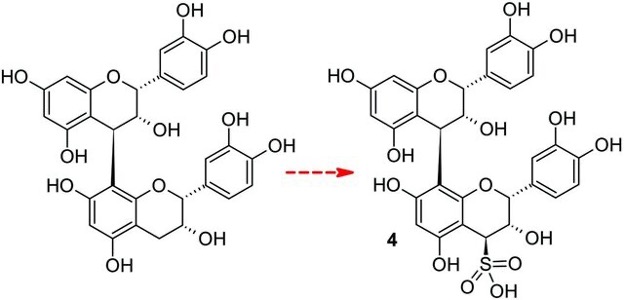Effect of SO2 on Tannin Evolution
Joy Ting
July 2020

Sulfonation of wine procyanidins occurring in wine, from: "Influences of Storage Conditions on the Composition of Red Wines
In addition to its effects on preserving fruit flavors and aromas, preventing oxidation and spoilage, and potentially muting flavors, SO2 has other impacts on the sensory perception of red wines through its interactions with phenolic groups. In red wines, bisulfite binds mainly to acetaldehyde and anthocyanins. When bisulfite binds to anthocyanins, it turns these pigments colorless, decreasing color intensity (1,2). Bisulfite also binds in the same location on the anthocyanin molecule that tannins would bind, therefore the presence of SO2 may delay or diminish the formation of more stable polymeric pigments (1). Polymeric pigments that have already formed resist bleaching by SO2 for this same reason (1). Binding of SO2 to anthocyanins is reversible, so as free SO2 decreases over time, anthocyanins may be released and gain color (3,4), however at wine pH, the bound form is highly favored (2).
In addition to its affect on color stability, the presence of SO2 also affects the polymerization of anthocyanins and tannins due to its interaction with acetaldehyde. Acetaldehyde forms bridges between tannin subunits and anthocyanins during polymerization, stabilizing the complexes until more long-term bonds can form. SO2binding to acetaldehyde prevents it from forming bridges. Without acetaldehyde, polymerization reactions are slower, including those among catechin molecules (formation of tannins) as well as between catechin and anthocyanins (formation of polymeric pigments)(5).
The polymerization of tannins is thought to diminish the astringency and bitterness of wine because larger tannins have less interaction with salivary proteins, so less polymerization in the presence of SO2 would thus lead to more astringent and bitter wines. However, recent work by Arapitsas et al (2018)(6) and the Waterhouse lab have shown this may not be the case. In a talk at the 69th ASEV conference, Andrew Waterhouse described discovering examples of sulfonated forms of anthocyanins and the monomers that make up tannins during an experiment examining quinone reactions during the phenolic cascade. In these experiments, the molecules were sulfonated at the position where tannins would normally bind. Normally, the bond that holds tannins together is broken by acid hydrolysis during aging, monomers are released, then re-polymerize over time to form less astringent tannins. Waterhouse hypothesized that in the presence of SO2, the SO2 binds to the subunits instead of another tannin or anthocyanin molecule, essentially stopping the polymer from growing. He also found tannins modified with sulfonation, meaning the chain of monomers was capped by a sulfur group. Despite the shortening of tannin complexes, Arapitsas et al (2018)(6) found that when tannin, acid and SO2 were all present, protein precipitation products were abolished, leading to a predicted softening of the astringency of wines.
Taken together, these studies reveal a new element of tannin evolution during aging that may significantly affect the sensory perception of astringency with wine age. After discussing the current view of tannin softening by tannin polymerization during aging, Arapitsas et al (2018)(6) conclude their work by saying “alongside these reactions, we should now add sulfonated monomeric and dimeric flavenols, which are expected to direct interaction with proteins… sulfonated flavanols, a class of compounds so far neglected, could play a role in improving the sensorial quality of red wine with aging.”
References
(1) Zoecklein, D. B. Sulfur Dioxide (SO2). Enology Notes Downloads, 16.
(2) Margalit, Y. Concepts in Wine Chemistry, 3rd ed.; The Wine Appreciation Guild LTD: San Francisco, California, 2012.
(3) Ribereau-Gayon, P.; Dubourdieu, D.; Doneche, B.; Lonvaud, A. Handbook of Enology Volume 1: The Microbiology of Wine and Vinifications, 2nd ed.; John Wiley & Sons: West Sussex, England, 2006.
(4) Stamp, C. How Much SO2 to Add and When. Wines and Vines 2011.
(5) Picinelli, A.; Bakker, J.; Bridle, P. V. Model Wine Solutions: Effect of Sulphur Dioxide on Colour and Composition during Ageing; 2015.
(6) Arapitsas, P.; Guella, G.; Mattivi, F. The Impact of SO2 on Wine Flavanols and Indoles in Relation to Wine Style and Age. Scientific Reports 2018, 8. https://doi.org/10.1038/s41598-018-19185-5.
(7) Mattivi, F.; Arpitsas, P.; Perenzoni, D. Influence of Storage Conditions on the Composition of Red Wines. ACS National Meeting Book of Abstracts, 2014, Chapter 3.
